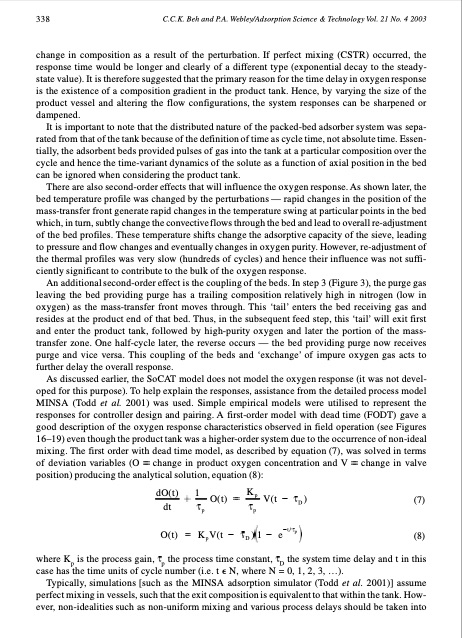
PDF Publication Title:
Text from PDF Page: 020
338 C.C.K. Beh and P.A. Webley/Adsorption Science & Technology Vol. 21 No. 4 2003 change in composition as a result of the perturbation. If perfect mixing (CSTR) occurred, the response time would be longer and clearly of a different type (exponential decay to the steady- state value). It is therefore suggested that the primary reason for the time delay in oxygen response is the existence of a composition gradient in the product tank. Hence, by varying the size of the product vessel and altering the flow configurations, the system responses can be sharpened or dampened. It is important to note that the distributed nature of the packed-bed adsorber system was sepa- rated from that of the tank because of the definition of time as cycle time, not absolute time. Essen- tially, the adsorbent beds provided pulses of gas into the tank at a particular composition over the cycle and hence the time-variant dynamics of the solute as a function of axial position in the bed can be ignored when considering the product tank. There are also second-order effects that will influence the oxygen response. As shown later, the bed temperature profile was changed by the perturbations — rapid changes in the position of the mass-transfer front generate rapid changes in the temperature swing at particular points in the bed which, in turn, subtly change the convective flows through the bed and lead to overall re-adjustment of the bed profiles. These temperature shifts change the adsorptive capacity of the sieve, leading to pressure and flow changes and eventually changes in oxygen purity. However, re-adjustment of the thermal profiles was very slow (hundreds of cycles) and hence their influence was not suffi- ciently significant to contribute to the bulk of the oxygen response. An additional second-order effect is the coupling of the beds. In step 3 (Figure 3), the purge gas leaving the bed providing purge has a trailing composition relatively high in nitrogen (low in oxygen) as the mass-transfer front moves through. This ‘tail’ enters the bed receiving gas and resides at the product end of that bed. Thus, in the subsequent feed step, this ‘tail’ will exit first and enter the product tank, followed by high-purity oxygen and later the portion of the mass- transfer zone. One half-cycle later, the reverse occurs — the bed providing purge now receives purge and vice versa. This coupling of the beds and ‘exchange’ of impure oxygen gas acts to further delay the overall response. As discussed earlier, the SoCAT model does not model the oxygen response (it was not devel- oped for this purpose). To help explain the responses, assistance from the detailed process model MINSA (Todd et al. 2001) was used. Simple empirical models were utilised to represent the responses for controller design and pairing. A first-order model with dead time (FODT) gave a good description of the oxygen response characteristics observed in field operation (see Figures 16–19) even though the product tank was a higher-order system due to the occurrence of non-ideal mixing. The first order with dead time model, as described by equation (7), was solved in terms of deviation variables (O change in product oxygen concentration and V change in valve position) producing the analytical solution, equation (8): (7) (8) where Kp is the process gain, p the process time constant, D the system time delay and t in this case has the time units of cycle number (i.e. t e N, where N = 0, 1, 2, 3, ...). Typically, simulations [such as the MINSA adsorption simulator (Todd et al. 2001)] assume perfect mixing in vessels, such that the exit composition is equivalent to that within the tank. How- ever, non-idealities such as non-uniform mixing and various process delays should be taken into dO(t) 1 O(t) Kp V(t D) dtp p O(t) KpV(t D) 1 et/pPDF Image | Dynamic Response and Characteristics of an Oxygen Vacuum Swing Adsorption

PDF Search Title:
Dynamic Response and Characteristics of an Oxygen Vacuum Swing AdsorptionOriginal File Name Searched:
026361703322405051.pdfDIY PDF Search: Google It | Yahoo | Bing
CO2 Organic Rankine Cycle Experimenter Platform The supercritical CO2 phase change system is both a heat pump and organic rankine cycle which can be used for those purposes and as a supercritical extractor for advanced subcritical and supercritical extraction technology. Uses include producing nanoparticles, precious metal CO2 extraction, lithium battery recycling, and other applications... More Info
Heat Pumps CO2 ORC Heat Pump System Platform More Info
| CONTACT TEL: 608-238-6001 Email: greg@infinityturbine.com | RSS | AMP |